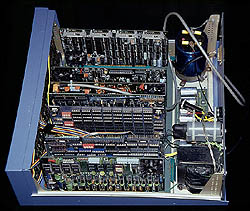Released in 1975
Developed by Ed Roberts and Les Solomon
Original price: $500
Named after the destination for the Star Ship Enterprise in an episode of the original "Star Trek" TV series in the 1970s, the Altair desktop personal computer enjoyed a brief, yet passionate fling with the hearts and minds of computer hobbyists.
 Altair 8080
Altair 8080From the Museum Collection |
Soloman and Roberts worked nights designing a desktop computer that could sell for less than $500. Robert's idea was to design a computer that could be expandable like minicomputers used by businesses.
An article detailing the Altair's workings was published in the January 1975 issue of Popular Electronics describing it as the "World's First Minicomputer Kit to Rival Commercial Models."
 Inside view of an Altair 8080
Inside view of an Altair 8080(Click on photo for larger view) From the Museum Collection |
The Altair had severe limitations. Data capacity of 256 bytes barely stored a paragraph's worth of information, which was lost as soon as the computer was powered down. Entering data was time-consuming, and quality control was virtually impossible as the machine's ability to perform as advertised was limited by the skill of the individual hobbyist who assembled it.
But two then-obscure programmers living in Boston recognized the Altair's potential. Bill Gates and Paul Allen had developed a BASIC programming language that would run on the Altair .
 Altair 8080 and floppy disk drive
Altair 8080 and floppy disk driveFrom the Museum Collection |
But the Altair is credited with helping provide the foundation for the future growth of the personal computing industy, inspiring such computer-centric traditions as users' groups, software swaps and computer shows and changing the way many people work and live.